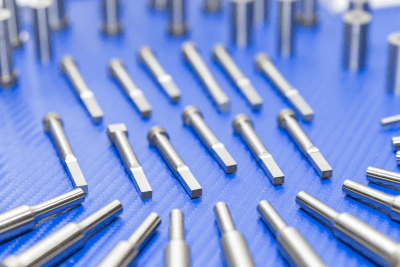What Is a Carbide Punch?

A carbide punch is a punch made of cemented carbide.
It is also called cemented carbide. Cemented carbide is a metal alloy made by adding tungsten carbide (WC) and titanium carbide (TiC), using cobalt (Co) powder as a binder, and sintering (pressing and solidifying the material at a temperature of 1300° to 1500° by heating it near its melting point) in a pressurized mold.
A carbide punch is a challenging and heat-resistant punch used for wear resistance. Regular punch material (equivalent to SKD11) becomes hard to cut when the cutting edge of the punch begins to sag due to frictional heat (around 1330°).
Uses of Carbide Punches
Carbide punches are a wear-resistant measure because they are made of carbide metal.
They are mainly used for precision dies and as punches for press dies. It is possible to maintain stable dimensions using carbide punches, which have little dimensional fluctuation due to wear.
Carbide punches have excellent wear resistance and are robust against compressive stress but weak against tensile stress, so the punch holding section must be reinforced when used.
Principle of Carbide Punches
Gold has the property of elongation when struck at room temperature.
However, iron does not elongate when struck at room temperature.
By adding heat to iron (around 1330°), it begins to elongate when struck.
In other words, gold has the same property at room temperature, and iron has the same property when heated to 1330°.
This is the difference between gold and iron.
The wear mechanism of the metal is that the part of the metal that comes in contact with the iron with the binder will be at around 1330° and
The metal becomes soft and wears by having the same properties as gold.
This is the wear mechanism.
If this is the case, to make a metal resistant to wear, it should not become soft even at a temperature of around 1330°.
This is called SKH51 (high-speed steel).
This is SKH51 (high-speed steel), a cemented carbide.
HSS is often used as a heat-resistant wear-resistant material because it begins to wear when heated to around 1550°.
Therefore, it is often used as a heat-resistant wear-resistant material.
Some cemented carbide materials do not wear out at temperatures above 2000° and even at 4000°.
You can understand how heat-resistant and hard they are.
However, it is not all merit.
Because of its hardness, it is less pliant and easily broken.
It is vital in compression but weak in tension and lateral force.